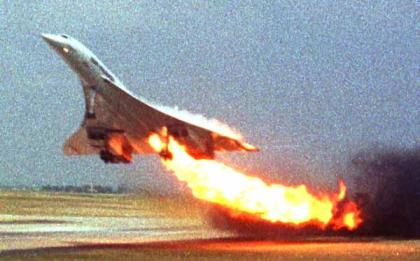Continental Airlines, five others to stand trial for July 2000 Concorde crash
03 Jul 2008
Cergy, France: US carrier Continental Airlines and five individuals, including two senior members of the Concorde programme, will stand trial over the crash of an Air France Concorde in July 2000 that killed 113 people, a prosecutor's statement said on Thursday. The defendants would be charged with involuntary manslaughter.
The proceedings are expected to start early next year and last two to three months, judicial officials said.
The New York-bound supersonic airliner crashed in flames minutes after take off from Paris' Charles De Gaulle airport on 25 July 2000, killing all 109 aboard and four people on the ground. A French inquiry into the accident concluded in December 2004 that the disaster was partly caused by a super-hard titanium strip that fell on the runway from a Continental Airlines plane that took off just before the Concorde.

The Concorde ran over the titanium strip, which shredded one of its tyres, causing a blowout and sending debris flying into an engine and a fuel tank. The French inquiry also found that a fault on Concorde's distinctive delta-shaped wings, which held its fuel tanks, contributed to the crash.
Continental Airlines and its workers are now charged in connection with a failure of aircraft maintenance. Its two employees, both US citizens, are John Taylor, a mechanic who allegedly fitted the non-standard strip, and the airline's chief of maintenance, Stanley Ford.
Continental has pledged to fight any charges in the case.
Of the former Concorde officials, Henri Perrier, 79, was director of the first Concorde programme at Aerospatiale, now part of the EADS group, from 1978 to 1994. It is surmised that he knew about a design fault in the aircraft since 1979 but failed to rectify it.
Jacques Herubel, 73, was Concorde's chief engineer from 1993 to 1995, during which period a similar incident occurred in London, with debris from a burst tyre puncturing a Concorde fuel tank but without causing an explosion.
As for Claude Frantzen, 71, he was director of technical services at the civil aviation authority DGAC from 1970 to 1994, during which period the Concorde was hit by a string of incidents.
The trial will aim to pin down the share of responsibility of the US airline, the Concorde and French aviation officials.
According to the prosecution, though the primary cause of the Concorde accident was because of the abandoned strip found on the tarmac, which caused the tyre to burst, but ''the disaster was only possible because mistakes were made in the maintenance of aircraft airworthiness that led to the explosion of the tyre and the loss of the aircraft."
The Concorde crash eventually led to all Concordes, both French and British, being taken out of service in 2003.
The plane, a British and French collaboration, made its maiden commercial flight in 1976. Only 20 were manufactured and 14 entered service. They mainly flew trans-Atlantic routes at speeds of up to 1,350 miles (2,170 kilometres) per hour.






















